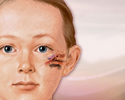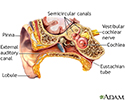Hearing loss
Decreased hearing; Deafness; Loss of hearing; Conductive hearing loss; Sensorineural hearing loss; PresbycusisHearing loss is being partly or totally unable to hear sound in one or both ears.
Considerations
Symptoms of hearing loss may include:
- Certain sounds seem overly loud in one ear
- Difficulty following conversations when two or more people are talking
- Difficulty hearing in noisy areas
- Trouble telling high-pitched sounds (such as "s" or "th") from one another
- Less trouble hearing men's voices than women's voices
- Hearing voices as mumbled or slurred
Associated symptoms may include:
- Feeling of being off-balance or dizzy (more common with Ménière disease and acoustic neuroma)
Ménière disease
Ménière disease is an inner ear disorder that affects balance and hearing.
 ImageRead Article Now Book Mark Article
ImageRead Article Now Book Mark ArticleAcoustic neuroma
An acoustic neuroma is a slow-growing tumor of the nerve that connects the ear to the brain. This nerve is called the vestibular cochlear nerve. It...
 ImageRead Article Now Book Mark Article
ImageRead Article Now Book Mark Article - Feeling of pressure in the ear (usually due to fluid behind the eardrum)
- Ringing or buzzing sound in the ears (tinnitus)
Tinnitus
Tinnitus is the medical term for "hearing" noises in your ears. It occurs when there is no outside source of the sounds. Tinnitus is often called "r...
 ImageRead Article Now Book Mark Article
ImageRead Article Now Book Mark Article
Causes
Conductive hearing loss (CHL) occurs because of a mechanical problem in the outer or middle ear. This may be because:
- Sound is not reaching the eardrum.
- The eardrum is not vibrating in response to sound.
- The 3 tiny bones of the ear (ossicles) are not conducting sound properly.
Causes of conductive hearing loss can often be treated. They include:
- Buildup of wax in the ear canal
- Damage to the very small bones (ossicles) that are right behind the eardrum
-
Fluid remaining in the ear after an ear infection
Fluid remaining in the ear
Otitis media with effusion (OME) is thick or sticky fluid behind the eardrum in the middle ear. It occurs without an ear infection. Note: This artic...
 ImageRead Article Now Book Mark Article
ImageRead Article Now Book Mark ArticleEar infection
Suspected ear infections are one of the most common reasons parents take their children to their health care provider. The most common type of ear i...
 ImageRead Article Now Book Mark Article
ImageRead Article Now Book Mark Article - Foreign object that is stuck in the ear canal
- Hole in the eardrum
- Scar on the eardrum from repeated infections
Sensorineural hearing loss (SNHL) occurs when the tiny hair cells (nerve endings) that detect sound in the inner ear are injured, diseased, do not work correctly, or have died. This type of hearing loss often cannot be reversed.
Sensorineural hearing loss is commonly caused by:
- Acoustic neuroma
-
Age-related hearing loss
Age-related hearing loss
Age-related hearing loss, or presbycusis, is the slow loss of hearing that occurs as people get older.
 ImageRead Article Now Book Mark Article
ImageRead Article Now Book Mark Article - Childhood infections, such as meningitis, mumps, scarlet fever, and measles
Meningitis
Meningitis is an infection of the membranes covering the brain and spinal cord. This covering is called the meninges.
 ImageRead Article Now Book Mark Article
ImageRead Article Now Book Mark ArticleMumps
Mumps is a contagious disease that leads to painful swelling of the salivary glands. The salivary glands produce saliva, a liquid that moistens food...
 ImageRead Article Now Book Mark Article
ImageRead Article Now Book Mark ArticleScarlet fever
Scarlet fever is caused by an infection with bacteria called group A streptococcus. This is the same bacteria that cause strep throat.
 ImageRead Article Now Book Mark Article
ImageRead Article Now Book Mark ArticleMeasles
Measles is a very contagious (easily spread) illness caused by a virus.
 ImageRead Article Now Book Mark Article
ImageRead Article Now Book Mark Article - Ménière disease
- Regular exposure to loud noises (such as from work or recreation)
- Use of certain medicines
Hearing loss may be present at birth (congenital) and can be due to:
- Birth defects that cause changes in the ear structures
- Genetic conditions (more than 400 are known)
- Infections the mother passes to her baby in the womb, such as toxoplasmosis, rubella, or herpes
Toxoplasmosis
Congenital toxoplasmosis is a group of symptoms that occur when an unborn baby (fetus) is infected with the parasite Toxoplasma gondii.
 ImageRead Article Now Book Mark Article
ImageRead Article Now Book Mark ArticleRubella
Congenital rubella is a condition that occurs in an infant whose mother is infected with the virus that causes German measles. Congenital means the ...
 ImageRead Article Now Book Mark Article
ImageRead Article Now Book Mark ArticleHerpes
Newborn infants can become infected with herpes simplex virus (HSV) during pregnancy, during labor or delivery, or after birth.
 ImageRead Article Now Book Mark Article
ImageRead Article Now Book Mark Article
The ear can also be injured by:
-
Pressure differences between the inside and outside of the eardrum, often from scuba diving
Pressure differences between the inside...
Ear barotrauma causes discomfort in the ear due to pressure differences between the inside and outside of the eardrum. It may include damage to the ...
 ImageRead Article Now Book Mark Article
ImageRead Article Now Book Mark Article - Skull fractures (can damage the structures or nerves of the ear)
- Trauma from explosions, fireworks, gunfire, rock concerts, and earphones
From explosions, fireworks, gunfire, ro...
Acoustic trauma is injury to the hearing mechanisms in the inner ear. It is due to very loud noise.
 ImageRead Article Now Book Mark Article
ImageRead Article Now Book Mark Article
Home Care
You can often flush wax buildup out of the ear (gently) with ear syringes (available in drug stores) and warm water. Wax softeners (like Cerumenex) may be needed if the wax is hard and stuck in the ear.
Take care when removing foreign objects from the ear. Unless it is easy to get to, have your health care provider remove the object. Don't use sharp instruments to remove foreign objects.
See your provider for any other hearing loss.
When to Contact a Medical Professional
Contact your provider if:
- Hearing problems interfere with your lifestyle.
- Hearing problems do not go away or become worse.
- The hearing is worse in one ear than the other.
- You have sudden, severe hearing loss or ringing in the ears (tinnitus).
- You have other symptoms, such as ear pain, along with hearing problems.
Ear pain
An earache is a sharp, dull, or burning pain in one or both ears. The pain may last a short time or be ongoing. Related conditions include:Otitis m...
 ImageRead Article Now Book Mark Article
ImageRead Article Now Book Mark Article - You have new headaches, weakness, or numbness anywhere on your body.
What to Expect at Your Office Visit
The provider will take your medical history and do a physical exam.
Tests that may be done include:
-
Audiometric testing (hearing tests used to check the type and amount of hearing loss)
Audiometric testing
An audiometry exam tests your ability to hear sounds. Sounds vary, based on their loudness (intensity) and the speed of sound wave vibrations (tone)...
 ImageRead Article Now Book Mark Article
ImageRead Article Now Book Mark Article -
CT or MRI scan of the head (if a tumor or fracture is suspected)
CT
A head computed tomography (CT) scan uses many x-rays to create pictures of the head, including the skull, brain, eye sockets, and sinuses.
 ImageRead Article Now Book Mark Article
ImageRead Article Now Book Mark ArticleMRI scan of the head
A head MRI (magnetic resonance imaging) is an imaging test that uses powerful magnets and radio waves to create pictures of the brain and surrounding...
 ImageRead Article Now Book Mark Article
ImageRead Article Now Book Mark Article -
Tympanometry
Tympanometry
Tympanometry is a test used to detect problems in the ear drum and middle ear.
 ImageRead Article Now Book Mark Article
ImageRead Article Now Book Mark Article
The following surgeries may help some types of hearing loss:
-
Eardrum repair
Eardrum repair
Eardrum repair refers to one or more surgical procedures that are done to correct a tear or other damage to the eardrum (tympanic membrane). Ossiculo...
 ImageRead Article Now Book Mark Article
ImageRead Article Now Book Mark Article -
Placing tubes in the eardrums to remove fluid
Placing tubes in the eardrums
Ear tube insertion involves placing tubes through the eardrums. The eardrum is the thin layer of tissue that separates the outer and middle ear. No...
 ImageRead Article Now Book Mark Article
ImageRead Article Now Book Mark Article - Repair of the small bones in the middle ear (ossiculoplasty)
The following may help with long-term hearing loss:
-
Assistive listening devices
Assistive listening devices
If you are living with hearing loss, you know that it takes extra effort to communicate with others. There are many different devices that can improv...
Read Article Now Book Mark Article - Safety and alert systems for your home
- Hearing aids
- Cochlear implant
-
Learning techniques to help you communicate
Learning techniques to help you communi...
If you are living with hearing loss, you know that it takes extra effort to communicate with others. There are techniques you can learn to improve co...
Read Article Now Book Mark Article - Sign language (for those with severe hearing loss)
Cochlear implants are only used in people who have lost too much hearing to benefit from a hearing aid.
References
Arts HA, Adams ME. Sensorineural hearing loss in adults. In: Flint PW, Francis HW, Haughey BH, et al, eds. Cummings Otolaryngology: Head and Neck Surgery. 7th ed. Philadelphia, PA: Elsevier; 2021:chap 152.
Eggermont JJ. Types of hearing loss. In: Eggermont JJ, ed. Hearing Loss. Cambridge, MA: Elsevier Academic Press; 2017:chap 5.
Kerber KA, Baloh RW. Neuro-otology: diagnosis and management of neuro-otological disorders. In: Jankovic J, Mazziotta JC, Pomeroy SL, Newman NJ, eds. Bradley and Daroff's Neurology in Clinical Practice. 8th ed. Philadelphia, PA: Elsevier; 2022:chap 22.
Le Prell CG. Noise-induced hearing loss. In: Flint PW, Francis HW, Haughey BH, et al, eds. Cummings Otolaryngology: Head and Neck Surgery. 7th ed. Philadelphia, PA: Elsevier; 2021:chap 154.
Shearer AE, Shibata SB, Smith RJH. Genetic sensorineural hearing loss. In: Flint PW, Francis HW, Haughey BH, et al, eds. Cummings Otolaryngology: Head and Neck Surgery. 7th ed. Philadelphia, PA: Elsevier; 2021:chap 150.
Weinstein B. Disorders of hearing. In: Fillit HM, Rockwood K, Young J, eds. Brocklehurst's Textbook of Geriatric Medicine and Gerontology. 8th ed. Philadelphia, PA: Elsevier, 2017:chap 96.
-
Ear anatomy - illustration
The ear consists of external, middle, and inner structures. The eardrum and the 3 tiny bones conduct sound from the eardrum to the cochlea.
Ear anatomy
illustration
Review Date: 5/2/2024
Reviewed By: Josef Shargorodsky, MD, MPH, Johns Hopkins University School of Medicine, Baltimore, MD. Also reviewed by David C. Dugdale, MD, Medical Director, Brenda Conaway, Editorial Director, and the A.D.A.M. Editorial team.



